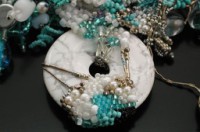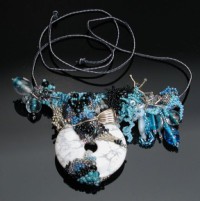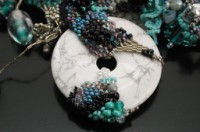First, I understand there is a subtle difference between gourd and peyote when worked in the round. I've been shown this difference, but I don't really understand it and I can't reproduce it–something about spacing and thread showing. To be perfectly frank, I don't care.
Second, I understand the really politically correct crowd doesn't like the “peyote” term. Unfortunately for them, the alternate never seems to have really caught on, though it looks like they might succeed in substituting herringbone for ndbele. Personally, I like the origins—and the people associated with it—incorporated right into the entymolgy. Sure the Ndbele do lots of different stitches, but it would be nice to give them credit for one, wouldn't it?
In any event, back when I took this class, ndbele was hardly known, and few people regularly worked in comanche/brick, square or single needle right angle weave (at least in my area). Peyote dominated, with netting stitches running second. Happily that's changing now, and there are more publications dedicated to spreading the word about new stitches and combinations.

Materials: howlite, silver, freshwater pearls, antique alumninum (very tiny, look closely), assorted glass beads, silk, nylon; Techniques: peyote, fringing, kumi.

Closeup, above. Gail Frederickson originally came up with this concept when one of her stone donuts broke and she built a necklace to cover the epoxy joins. I was enchanted, and figured a class would get me to practice the relevant techniques, and be social. Besides I might actually learn something.

I didn't think something that involved so much work should hang on something as plebian as a 2mm black leather cord, so I substituted this 11 strand triangular silk cord instead. The pattern is in Roderick Owen's braid book.

Closeup, dark side. The kit came with lots and lots of different kinds of beads, so necessary to this freeform technique, but of course, I couldn't help adding a few more–freshwater pearls, sterling tubes, rounds, and shapes, 15/0s in matching colors. One view shows the white side of the piece; the other substitutes mostly black, to give two different views.
$900
update, 14aug04 (closeups added—click on thumbnails for full-size images)
Unless otherwise noted, text, image and objects depicted therein copyright 1996--present sylvus tarn.
Sylvus Tarn